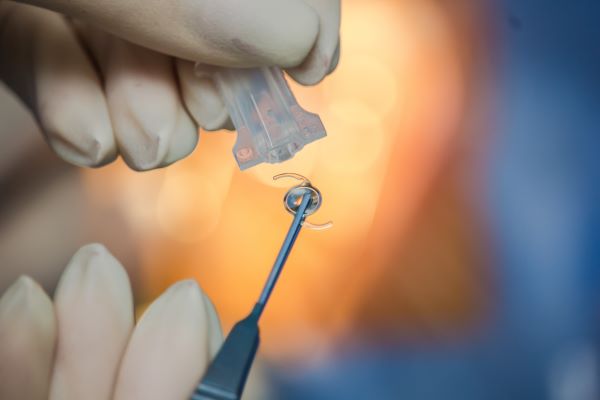Clear Up Cataract Sx Coding Confusion in 3 Simple Steps
Remember: You won’t always bill for the lens, and some aren’t fully covered. Nearly 20 percent of adults over 40 have a cataract in one or both eyes, and recent estimates suggest that the more than four million cataract surgeries performed annually in the United States will double within the next 15-20 years. Given these numbers, your eye care practice likely sees patients with this vision-threatening condition practically every day, requiring you to understand how to differentiate between the growing number of codes for cataract extraction. Fortunately, we’ve broken it all down in this handy guide to help you overcome cataract coding challenges and achieve success with these surgical claims every time. Be Familiar With Cataract Basics A cataract is an opacity or loss of optical clarity of the crystalline lens. Age-related cataract (senile) is the most common type found in adults. While not seen as often, other types of cataracts include pediatric (both congenital and acquired), traumatic, toxic, and secondary (result of another disease process). Currently, there is no medical treatment for cataracts, so ophthalmologists perform cataract surgery to alleviate visual impairments attributable to lens opacity. Luckily, it’s a routine, safe procedure, and technological advancements have significantly improved both the methods for removing cataracts and the types of customized lenses available. Study These Commonly Scrutinized Codes At the top of many auditors’ list of codes to check for documentation compliance are the following novel or frequently reported cataract surgery CPT® codes: When coding these cases, you should start by scouring the op note for surgery specifics and find the descriptor that best matches the procedures performed. Work with your ophthalmic surgeons to ensure they understand the details needed for proper code selection. Claim success hinges on documentation of medical necessity in the medical record and a comprehensive account of what was done in the operating room. Watch out: The word “complexity” in the descriptor for 66982 is not related to the surgeon’s perception of the surgical difficulty, and you should not use it simply because they encounter a surgical complication. The use of this code is governed by the need to employ devices or techniques not generally used in routine cataract surgery. In addition, even though the descriptor for 66982 mentions an intraocular lens (IOL), that alone is not enough to justify the code. “It would be the [IOL] suture support that elevates the procedure from 66984 to 66982,” says Brett Rosenberg, MA, CPC, CCS-P, COC, virtual instructor-led training faculty manager at AAPC. Combination procedures: Over the past few years, CPT® has expanded the code set to include codes that describe procedures involving cataract surgery and a glaucoma treatment: 66987 and 66988 involve endoscopic cyclophotocoagulation, while codes 66989 and 66991 include insertion of an aqueous drainage device. When you report these codes, your documentation of medical necessity for each procedure must be clear. “Ensure that the documentation supports the criteria for the glaucoma portion of the case as well as the criteria for the cataract portion,” advises Mary Pat Johnson, CPC, CPMA, COMT, COE, senior consultant with Corcoran Consulting Group. In some cases, ophthalmic surgeons will remove a cataract without implanting an IOL. Report the cataract extraction using the following CPT® codes: Second eye surgery: If a symptomatic cataract is present in both eyes, the surgeon will generally perform surgery one eye at a time to avoid the potential for vision loss in both eyes. They will typically address the second cataract after an appropriate interval has passed. Understand Billing for IOL Upgrades Many cataract procedures include the insertion of an intraocular lens prosthesis. If the provider performs the procedure in a facility setting, the IOL is almost always reimbursed as part of the payment to the facility, and you should not code separately for the lens supply. However, when the physician performs the surgery in an office, you can report V2632 (Posterior chamber intraocular lens) for a conventional IOL. Note: Medicare only covers a standard IOL. When patients opt for a lens upgrade, they will be responsible for the extra cost associated with the presbyopia or astigmatism correction. When the ophthalmologist performs surgery in the office, the practice may collect the payment for the non-covered upgrade features of the IOL. You can code this extra portion with HCPCS Level II code V2787 (Astigmatism correcting function of intraocular lens) for an astigmatism-correcting IOL (A-C IOL) and V2788 (Presbyopia correcting function of intraocular lens) for a presbyopia-correcting IOL (P-C IOL). More often, providers perform surgery in an ambulatory surgery center (ASC) or hospital, and that facility will collect the fee. Since Medicare will not pay the extra cost, the responsibility for payment for V2787 or V2788 will ultimately fall to the patient. While reporting V2787 or V2788 to Medicare is optional, the patient may ask you to do so in order to receive a denial that they can then submit to a secondary payer to receive payment. In that case, you should append modifier GY (Item or service statutorily excluded, does not meet the definition of any Medicare benefit or, for non-Medicare insurers, is not a contract benefit) to the V code. “Instructions from non-Medicare payers, including Medicare Advantage plans (Part C Medicare) vary. Seek instructions from the plans prior to surgery. Always document the patient’s understanding and acceptance of financial responsibility on an ABN [Advance Beneficiary Notice] or suitable waiver prior to surgery,” Johnson advises.





